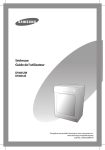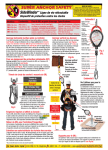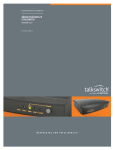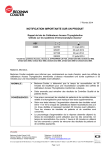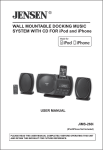Download Ampex Data Systems ATM 300 User's Manual
Transcript
ATM 300 Series Tape Recorder Interface Installation and Operation ™ 1308903-02 NOTICE The contents of this technical manual have been checked and are believed to be accurate. However, no responsibility is assumed for any inaccuracies in the information provided herein. Ampex Corporation reserves the right to make changes without notice to improve reliability, function or design. TRADEMARKS DIS is a registered trademark of Ampex Corporation. Prepared by Technical Publications Ampex Corporation 500 Broadway Redwood City, CA 94063-3199 Copyright © 1998 by Ampex Corporation All rights reserved Part No. 1308903-02 Issued: March 1998 Technical Information Customer Support Ampex provides extensive customer support for its products. These services are outlined below. When requesting services, please supply the following information (most of which can be found on the identification name plate located on the system’s rear panel) to help expedite your request. • • • • • Model Serial Number Catalog/part number Date of purchase Name and address of your organization Field Service For service quotations and scheduling, call the Ampex Customer Service Center at 800-DST-SRVC (800-378-7782) or 719-596-2000. Parts and Accessories Within the United States, call 800-227-8402 for information and quotations on replacement parts, lists of spares, and accessories to use with your system. Outside the United States, call 719-570-3DST (719-570-3378) in Colorado Springs, Colorado, USA or fax 719-570-3289. Technical Support If you require information or technical assistance that is not available in your local area, contact the Ampex Customer Service Department for assistance: Ampex Corporation Customer Service 600 Wooten Road Colorado Springs, CO 80915-3597 Telephone: 800-DST-SRVC (800-378-7782) or 719-570-3378 Fax: 719-570-3289 International Telephone: 719-570-3378 E-mail address: [email protected] (USA) or [email protected] (UK) Website: http://www.ampex.com Training Services Ampex offers technical (maintenance) training on this and other data storage products on a scheduled basis. For further information regarding training, call : 800-227-8402 719-570-3714 719-570-3329 (FAX). iii Safety and First Aid Suggestions No matter how well electrical equipment is designed, you can be exposed to dangerous electrical shock when protective covers are removed for service or other activities. Therefore, you should consistently observe all safety regulations, be sure that you thoroughly understand the dangers related to electrical hazards, and have some knowledge of first aid required for electrical injuries. In addition, follow these general safety practices: Do not touch or adjust unprotected circuit controls or dress leads with the power on. Always avoid placing parts of the body in series between ground and circuit points. To avoid burns, do not touch heavily loaded or overheated components without taking precautions. Remember that some semiconductor cases and solid-state circuits carry high voltages. Do not assume there is no danger of electrical shock when power is off. Charged capacitors can retain high voltages for a long time after power is turned off. You should discharge capacitors through a suitable resistor before touching any circuit points. Don’t take chances. Be fully trained. Only qualified personnel should operate and maintain Ampex equipment. Muscular spasm or unconsciousness can prevent a victim from freeing himself from the electrical power. If someone appears to have received an electrical shock, turn power off before attempting first aid. DANGER! Do not touch electrical shock victims or their clothing before disconnecting power. You can also become a shock victim. iv Good Practices If you cannot turn off power immediately, very carefully loop a length of dry, nonconducting material (such as rope, insulating material, or clothing) around the victim and pull him free of the power. Avoid touching the victim or victim’s clothing until free of power. Immediately start the appropriate first aid procedures. When testing or servicing the equipment described in this manual, keep in mind the following standard good practices: When connecting any instrument (oscilloscope, waveform monitor, etc.) to a high-frequency output, use the appropriate termination resistor at the input of the instrument unless the instrument is terminated internally. When inserting or removing printed wiring assemblies (PWAs), cable connectors, or fuses, always turn off power to the affected portion of the equipment. After removing power, allow sufficient time for the power supplies to bleed down before reinserting PWAs. To avoid damage to PWA components from static electricity, use standard static-safe handling procedures such as wearing a grounded wrist strap and working on grounded conductive surfaces. v Notice! This equipment generates, uses, and can radiate radio frequency energy. If not installed and used in accordance with the instruction manual, it may cause interference to radio communications. This equipment has been tested and found to comply with the limits for a Class A digital device pursuant to part 15 of FCC rules, which are designed to provide reasonable protection against such interference when operated in a commercial environment. Operation of this equipment in a residential area is likely to cause interference, in which case the users will be required to correct the interference at their own expense. This system was tested using the shielded interconnect cables provided with the unit. Failure to use the cables provided may result in radio interference outside acceptable limit vi ATM 300 Series Contents Contents 1.0 1.1 1.2 1.3 1.4 1.5 1.6 1.7 1.8 Ampex 1308903-02 Introduction .......................................................................................................1 Description ........................................................................................................1 Unpacking and Inspection .................................................................................2 Rack Mounting ..................................................................................................2 Data Connections ..............................................................................................2 Multiple ATM 300S/M Connections ................................................................3 Switches and Indicators .....................................................................................5 Operation ...........................................................................................................6 Self-Test ............................................................................................................6 vii ATM 300 Series 1.0 Introduction Introduction This manual describes how to install and operate the Ampex ATM 300 Series Tape Recorder Interface. 1.1 Description Ampex provides three models of the ATM 300 Series Tape Recorder Interface: • • • ATM 300 - Multimode fiber physical layer interface ATM 300S - Singlemode fiber physical layer interface with SyncStart ATM 300M - Multimode fiber physical layer interface with SyncStart These three units convert OC-3 (Optical Carrier) data to HOTLink™ serial data for recording to an Ampex DIS tape drive. During playback, the units convert HOTLink serial data from the DIS tape drive to OC-3 optical data at a continuous 19.44 megabytes (MB) per second. Figure 1 shows a typical single unit configuration. RECORD IN ASYCHRONOUS TRANSFER MODE (ATM) SWITCH ATM 300 SERIES HOTLINK OUT DIS 160i/162i TAPE DRIVE OR DIS 260i/262i/860i/862i ACL PLAY FIBER OPTIC DEVICE Figure 1. Typical Configuration Table 1 lists the ATM 300 specifications. Table 1. Specifications Parameter Data Interfaces Fiber Optic Electrical Serial Specification ATM (Asynchronous Transfer Mode), OC-3 (Optical Carrier) and SONET formats Cypress HOTLink Data Transfer Rate OC-3 HOTLink 19.44 MB/sec (155.52 Mbits/sec) 0-32 MB/sec (0-256 Mbits/sec) Optical Wavelength 1300 nm Optical Connectors Duplex SC Ampex 1308903-02 1 Model No. ATM 300 Series Running Head Unpacking and Inspection Table 1. Specifications (Continued) Parameter 1.2 Specification Optical Data Cables 62.5/125 µm multimode fiber (ATM 300 and ATM 300M) 8.3/125 µm singlemode fiber (ATM 300S) Electrical Data Cables Ampex provides the following accessory cable kits: Ampex Part No. Size 1308564-01 120-in (305 cm) - standard 1308565-01 180-in (457 cm) 1308566-01 300-in (762 cm) 1308567-01 600-in (1524 cm) SyncStart Connector BNC Power Requirements 100-240 Vac, 47-63 Hz single phase, 150 watt maximum Dimensions 19” (480 mm) rack mountable 17.0” W x 1.875” H x 8.0” D (432 mm x 48 mm x 203 mm) Unpacking and Inspection Perform the following inspection upon receipt of the unit: 1. Unpack and check the unit for shipping damage. If equipment is damaged notify the carrier immediately. 2. Check equipment received against the packing list to ensure that the shipment is complete. If any shortages exist, promptly contact the sales representative. 1.3 Rack Mounting Ampex ships the ATM as a desk top unit. However, the unit can be mounted into a standard 19-inch (284 mm) rack using the hardware provided. To mount the unit into a rack, install the two brackets on either side of the unit using the four machine screws provided. Then, mount the completed assembly to the rack rails. 1.4 Data Connections The ATM unit provides fiber optic connectors on the front panel and HOTLink connectors on the rear panel. Figure 2 shows the cable connections. See Table 1 for cable specifications. 2 Ampex 1308903-02 ATM 300 Series Multiple ATM 300S/M Connections FRONT PANEL REAR PANEL OUT RECEIVER FIBER OPTIC DEVICE HOTLINK INTERFACE TRANSMITTER SERIAL IN DIS 160i IN SERIAL OUT ATM 300 SERIES NOTE: SEE TABLE 1 FOR CABLE AND CONNECTOR SPECIFICATIONS. Figure 2. Single OC-3 Connection 1.5 Multiple ATM 300S/M Connections To synchronize data transfers to and from the multiple tape drives, connect a user supplied SyncStart signal to multiple ATM 300S/M units. The SyncStart signal synchronizes the data transfers to the tape drives during record, and from the tape drives during playback. Figure 3 shows a record/playback configuration across multiple tape drives with synchronized OC-3 interfaces. The SyncStart signal is a level sensitive transistor-to-transistor logic (TTL) signal. A high (high TTL level or no connection) signal enables data to and from the tape drive. A low (low level TTL or ground) disables data to and from the tape drive. Tie all SyncStart inputs to a common control signal to synchronize data transfers across multiple tape drives. The ATM unit internally debounces the SyncStart signal so that the low-to-high transition enables data to flow immediately. For high-to-low transitions, the unit debounces the signal for approximately 3 ms before it disables the data flow. Therefore, if you use a toggle switch or relay to provide a contact closure to ground as the SyncStart input, then the first disconnect from ground will enable data flow. If the switch or relay is noisy and produces bounces back to ground, the data flow will remain enabled. Only a 3-ms or greater low level signal will disable the data flow. (Typically, switch or relay contacts open with much less noise than when they are closed.) Ampex 1308903-02 3 Model No. ATM 300 Series Running Head Multiple ATM 300S/M Connections FRONT PANEL REAR PANEL OUT RECEIVER FIBER OPTIC DEVICE SERIAL IN HOTLINK INTERFACE TRANSMITTER DIS 160i IN SYNCSTART SERIAL OUT ATM 300S/M FRONT PANEL REAR PANEL RECEIVER OUT FIBER OPTIC DEVICE SERIAL IN HOTLINK INTERFACE TRANSMITTER DIS 160i IN SYNCSTART SERIAL OUT ATM 300S/M FRONT PANEL REAR PANEL OUT RECEIVER FIBER OPTIC DEVICE SERIAL IN HOTLINK INTERFACE TRANSMITTER IN SYNCSTART DIS 160i SERIAL OUT ATM 300S/M SYNCSTART SIGNAL (TOGGLE SWITCH, RELAY, ETC.) ENABLE DISABLE Figure 3. Multiple OC-3 Connection 4 Ampex 1308903-02 ATM 300 Series 1.6 Switches and Indicators Switches and Indicators Table 2 describes the front and rear panel switches and indicators. Table 2. Switches and Indicators Panel Front Name DATA FLOW (switch) TRANSMITTER EMPTY (yellow indicator) Rear Description Determines how the ATM unit responds to a missing or invalid OC-3 input. CONTINUOUS - Continues record and playback operations at 155.52 Mbits/sec as determined by an internal crystal oscillator. This provides a valid OC-3 output during playback regardless of the OC-3 input status. GATED - Pauses record and playback operations until valid OC-3 input is restored. The ATM unit resumes normal operation after the OC-3 input is restored. Indicates data rate from the tape drive is too slow. This is to be expected whenever the tape drive is not supplying data. FULL (red indicator) Indicates data rate from the tape drive is too fast. This is an abnormal condition and most likely indicates that the tape drive is not using its write input to regulate its playback rate (internal playback clock* should be disabled). OK (green indicator) Indicates correct data rate from the tape drive. RECEIVER OK (green indicator) Indicates ATM unit receiving valid OC-3 optical signal input. POWER (green indicator) Indicates ATM unit is powered-up. POWER (switch) ON - Powers up the ATM unit. OFF - Powers down the ATM unit. TEST LOOP (switch) TEST - Self test operation. NORMAL - Normal operation. ERROR (red indicator) Indicates (during normal operation) that a valid HOTLink input is missing. RESET (button) Resets the ATM unit during normal operation. *For setting internal playback clock options, see DIS Tape Drive or ACL Installation and Operation manual. Ampex 1308903-02 5 Model No. ATM 300 Series Running Head Operation 1.7 Operation To operate the ATM units: 1. For initial installations, perform the self-test procedure in paragraph 1.8. 2. Verify the TEST LOOP switch, on the rear panel, is in the NORMAL position. 3. Place the POWER switch to the ON position. The POWER indicator should light. 4. Verify the ERROR indicator (rear panel) is off. 5. Verify the tape drive is setup for External Playback Clock (see DIS Tape Drive or ACL Installation and Operation manual). 6. Set the DATA FLOW switch to CONTINUOUS or GATED as required (see Table 2). 7. Perform record or playback operations. For synchronized data transfers in multiple OC-3 interfaces (see paragraph 1.5) control the SyncStart signal as follows: a. For record operations, hold the common SyncStart signal low until all tape drives are ready to accept data and the desired input data is available. Set the common SyncStart signal high, to begin delivering data from the ATM units to their respective tape drives. b. For playback operations, hold the common SyncStart signal low until all tape drives are ready to deliver data and the unit accepting data is ready. Set the common SyncStart signal high to begin providing data to the units accepting data. 1.8 Self-Test To perform the self-test: 1. Loop the fiber optic and HOTLink cables as shown in Figure 4. FRONT PANEL REAR PANEL RECEIVER OUT HOTLINK INTERFACE TRANSMITTER HOTLINK LOOP IN FIBER OPTIC LOOP ATM 300 Figure 4. Self-Test 6 Ampex 1308903-02 ATM 300 Series Self-Test 2. Place the POWER switch to the ON position. The following indicators should be on: • • • POWER RECEIVER OK TRANSMITTER OK 3. Place the TEST LOOP switch to the TEST position. 4. Press the RESET button. The ERROR indicator should go off and remain off indicating unit is operating properly. If necessary, check cable connections. Otherwise, call your local Ampex regional office. Ampex 1308903-02 7 ™ Ampex Corporation 500 Broadway Redwood City, CA 94063-3199 Part Number 1308903-02

















